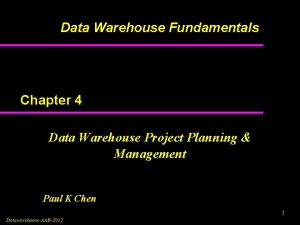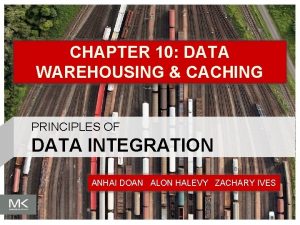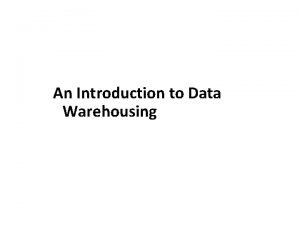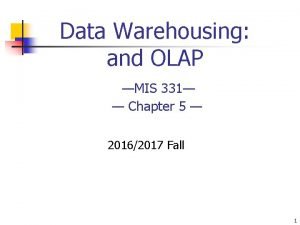Virtual University of Pakistan Data Warehousing Lecture11 Multidimensional
















- Slides: 16

Virtual University of Pakistan Data Warehousing Lecture-11 Multidimensional OLAP (MOLAP) Ahsan Abdullah Assoc. Prof. & Head Center for Agro-Informatics Research www. nu. edu. pk/cairindex. asp National University of Computers & Emerging Sciences, Islamabad Email: ahsan@cluxing. com Ahsan Abdullah 1

Multidimensional OLAP (MOLAP) 2 Ahsan Abdullah

OLAP Implementations 1. MOLAP: OLAP implemented with a multidimensional data structure. 2. ROLAP: OLAP implemented with a relational database. 3. HOLAP: OLAP implemented as a hybrid of MOLAP and ROLAP. 4. DOLAP: OLAP implemented for desktop decision support environments. 3 Ahsan Abdullah

MOLAP Implementations OLAP has historically been implemented using a multi_dimensional data structure or “cube”. § Dimensions are key business factors for analysis: § § § Geographies (city, district, division, province, . . . ) Products (item, product category, product department, . . . ) Dates (day, week, month, quarter, year, . . . ) § Very high performance achieved by O(1) time lookup into “cube” data structure to retrieve pre_aggregated results. 4 Ahsan Abdullah

MOLAP Implementations § No standard query language for querying MOLAP - No SQL ! § Vendors provide proprietary languages allowing business users to create queries that involve pivots, drilling down, or rolling up. - E. g. MDX of Microsoft - Languages generally involve extensive visual (click and drag) support. - Application Programming Interface (API)’s also provided for probing the cubes. 5 Ahsan Abdullah

Aggregations in MOLAP § Sales volume as a function of (i) product, (ii) time, and (iii) geography § A cube structure created to handle this. District Month City Zone Ge Milk S 23 Bread 8 Category Division Quarter Product N W E Product Hierarchical summarization paths Industry Province Year og Dimensions: Product, Geography, Time Eggs 45 Week Butter 13 Jam 12 Juice 10 Day w 1 w 2 w 3 w 4 w 5 w 6 Time Ahsan Abdullah 6

Cube operations § Drill down: get more details § e. g. , given summarized sales as above, find breakup of sales by city within each region, or within Sindh § Rollup: summarize data § e. g. , given sales data, summarize sales for last year by product category and region § Slice and dice: select and project § e. g. : Sales of soft-drinks in Karachi during last quarter § Pivot: change the view of data Ahsan Abdullah 7

Querying the cube Drill-Down Roll-Up 2001 2002 Drill-down 8 2001 Ahsan Abdullah 2002

Querying the cube: Pivoting 9 Ahsan Abdullah

MOLAP evaluation Advantages of MOLAP: n Instant response (pre-calculated aggregates). n Impossible to ask question without an answer. n Value added functions (ranking, % change). 10 Ahsan Abdullah

MOLAP evaluation Drawbacks of MOLAP: § Long load time ( pre-calculating the cube may take days!). § Very sparse cube (wastage of space) for high cardinality (sometimes in small hundreds). e. g. number of heaters sold in Jacobabad or Sibi. 11 Ahsan Abdullah

MOLAP Implementation issues Maintenance issue: Every data item received must be aggregated into every cube (assuming “to-date” summaries are maintained). Lot of work. Storage issue: As dimensions get less detailed (e. g. , year vs. day) cubes get much smaller, but storage consequences for building hundreds of cubes can be significant. Lot of space. 12 Ahsan Abdullah

Partitioned Cubes § To overcome the space limitation of MOLAP, the cube is partitioned. § The divide&conquer cube partitioning approach helps alleviate the scalability limitations of MOLAP implementation. § One logical cube of data can be spread across multiple physical cubes on separate (or same) servers. § Ideal cube partitioning is completely invisible to end users. § Performance degradation does occurs in case of a join across partitioned cubes. Ahsan Abdullah 13

Partitioned Cubes: How it looks Like? Men’s clothing Children clothing Bed linen Time Product Geography Sales data cube partitioned at a major cotton products sale outlet 14 Ahsan Abdullah

Virtual Cubes Used to query two dissimilar cubes by creating a third “virtual” cube by a join between two cubes. § Logically similar to a relational view i. e. linking two (or more) cubes along common dimension(s). § Biggest advantage is saving in space by eliminating storage of redundant information. Example: Joining the store cube and the list price cube along the product dimension, to calculate the sale price without redundant storage of the sale price data. 15 Ahsan Abdullah

Summary 16 Ahsan Abdullah
 Data mining in data warehouse
Data mining in data warehouse Hive
Hive Olap data mart
Olap data mart Olap data warehouse
Olap data warehouse Best practices for data warehousing
Best practices for data warehousing Introduction to data mining and data warehousing
Introduction to data mining and data warehousing Multidimensional space in data mining
Multidimensional space in data mining Difference between operational and informational data
Difference between operational and informational data Greenplum data warehousing
Greenplum data warehousing Data warehousing components
Data warehousing components Data warehousing project management
Data warehousing project management Temporal parallelism
Temporal parallelism Data warehousing principles
Data warehousing principles Chicago time
Chicago time Introduction to data warehouse
Introduction to data warehouse An overview of data warehousing and olap technology
An overview of data warehousing and olap technology Concept hierarchy in data warehousing
Concept hierarchy in data warehousing































